Essential Cold Email Templates for Every Outreach Purpose

Mastering the Art of Cold Email Templates: A Complete Guide
Cold email templates are crucial in today's digital networking world, where outreach and communication often begin with an unsolicited email. A well-crafted cold email template can serve as your first point of contact with potential clients, partners, or employers, setting the tone for future conversations. Unlike traditional email, a cold email approaches recipients who have no prior relationship with the sender, making it essential to create a positive first impression. This article explores various aspects of cold email templates and the best practices to ensure success in your outreach efforts.
The heart of a successful cold email lies in its structure and content. A cold email template should capture the recipient's attention immediately with a compelling subject line, present relevant information concisely in the body, and include a clear call to action. By utilizing cold email templates, professionals can streamline their outreach process while still personalizing the message for each recipient. Whether you're reaching out for sales, networking, job opportunities, or industry introductions, having a reliable cold email template can make a significant difference in your response rate.
In addition to crafting well-structured email templates, understanding the audience is equally critical. Cold email templates should reflect a strong understanding of the recipient's interests, challenges, and needs. The templates can be tailored to various purposes, including sales outreach, networking opportunities, job applications, and legal considerations. With the right template, professionals can enhance their ability to engage prospects, foster relationships, and ultimately, achieve their outreach goals.
Furthermore, it's important to consider the ethical and legal aspects of cold emailing. As outreach becomes more prevalent, laws such as GDPR and CAN-SPAM set guidelines for sending marketing emails. Knowing these regulations is crucial for ensuring compliance and maintaining a positive reputation. In this guide, we will delve into the best practices, various templates for different outreach contexts, and important legal considerations to keep in mind when creating your cold email templates.
By the end of this article, readers will have a comprehensive understanding of how to create effective cold email templates. With actionable insights and sample templates, you will be well-equipped to connect with new leads, nurture your professional network, or explore job opportunities through cold emailing.
Best Practices for Cold Emailing
Crafting a compelling subject line is crucial for cold emails. It should be clear, concise, and engaging enough to catch the recipient's attention. A subject line that piques curiosity or highlights a benefit can significantly increase the chances of your email being opened. Avoid using clickbait or misleading information, as this can harm your credibility.
Personalization techniques are vital when using cold email templates. Tailor your message by addressing the recipient by name and incorporating specific details relevant to them. Mentioning a mutual connection, referencing recent achievements, or discussing industry trends can help establish rapport and make the email stand out.
Timing your cold email for maximum impact involves understanding when your recipients are most likely to check their emails. Research suggests that sending emails early in the week or during late mornings maximizes open rates. Additionally, consider the recipient's time zone to ensure your email hits their inbox at an appropriate time.
Crafting a compelling outreach strategy begins with a well-structured cold email template that captures your audience's attention.
Follow-up strategies for cold emails can be crucial, as many recipients may overlook the initial email. Sending a polite follow-up a few days after the first email can help jog their memory and demonstrate your interest. Keep follow-ups concise, friendly, and respectful of their time.
Analyzing cold email success metrics allows senders to understand which templates resonate with their audience. Metrics such as open rates, response rates, and conversion rates can provide valuable insights into your outreach efforts. Continuously testing and refining your templates based on these metrics can improve your overall success rate.
Cold Email Templates for Sales Outreach
For initial sales outreach, it is essential to craft a cold email template that highlights the value your product or service offers. Begin with a personalized greeting, briefly introduce yourself, and explain how your solution addresses a specific pain point for the recipient's business. Conclude with a clear call-to-action, such as scheduling a demo or a follow-up call.
Follow-up email templates for sales leads play a significant role in nurturing prospects. After the initial outreach, a follow-up email can remind recipients of your previous conversation and reinforce the benefits of your solution. Be polite and concise, and include a prompt for the next steps.
Cold email templates for re-engagement can rekindle interest with past contacts or leads who went cold. Such templates should acknowledge the previous interaction, express genuine interest in reconnecting, and present any new offers or updates that may benefit the recipient.
Templates for referral requests can be highly effective in expanding your network or client base. These emails should clearly explain why you are reaching out for a referral and provide specific criteria for the ideal candidate you wish to connect with. A respectful tone will increase the likelihood of a positive response.
Case study email templates can showcase your product or service's success stories. Sharing compelling results from previous clients can build trust and highlight your solution's effectiveness. Attach a case study or offer to provide detailed information to engage the recipient further.
Cold Email Templates for Networking
Networking introduction email templates should clearly articulate who you are and why you are reaching out. A brief introductory paragraph followed by a specific request for connection, meeting, or collaboration can open doors to potential professional relationships.
Cold email templates for industry connections should express genuine interest in the recipient's work while detailing your background and how you believe a connection would be mutually beneficial. Mentioning specific projects or achievements can also personalize the email.
Follow-up networking emails should express gratitude for the recipient's time during a prior conversation or meeting. It’s an opportunity to reinforce any points discussed and offer additional information or resources that may add value to the relationship.
Thank you emails after networking events are crucial for maintaining connections established during events. A short and sincere thank-you note can leave a lasting impression and encourage future engagement.
Reaching out to mentors via cold email requires a respectful approach. Clearly outline your admiration for their work, what you hope to learn, and a request for their guidance or mentorship. Make it easy for them to understand how to respond positively to your request.
Cold Email Templates for Job Applications
Cold email templates for job inquiries should express enthusiasm about the company or specific roles. Highlight your skills and experiences relevant to the position and kindly request a conversation to learn more about potential opportunities.
Networking for job opportunities email templates can help establish connections within your industry. Mention any shared interests or contacts, and ask for advice or insights regarding job openings or the company culture.
Follow-up emails after job applications can enhance your chances of being noticed. Politely inquire about the application status and reiterate your enthusiasm for the position while briefly reminding them of your relevant qualifications.
Cold emails to company HR departments should target specific roles you are interested in. Provide a brief overview of your professional background and express genuine interest in contributing to the company.
Proposal emails for freelance opportunities should clearly state your proposal, including the scope of work, goals, and how you can provide value. Attach relevant samples of your work, and invite further discussion to solidify the proposal.
Legal Considerations for Cold Emailing
Understanding GDPR and cold emails is essential for maintaining compliance when emailing prospects in Europe. Personal data must be processed responsibly, and recipients should have the ability to opt-out of future communications.
CAN-SPAM Act compliance for cold email templates requires senders to adhere to legal standards when sending marketing emails. Key requirements include identifying the sender, providing an unsubscribe option, and avoiding misleading subject lines.
Best practices to avoid spam filters include maintaining a clean email list, using a recognizable sender name, and avoiding spammy language. Personalizing emails and keeping the content relevant can also help avoid filters.
Consent in cold emailing is a vital part of ethical outreach. Obtaining consent from recipients and being transparent about how their data will be used builds trust and reduces the risk of being marked as spam.
Record-keeping for cold email outreach is crucial for tracking consent and communication history. Proper documentation can protect your business from compliance issues and provide insights into your outreach effectiveness.
